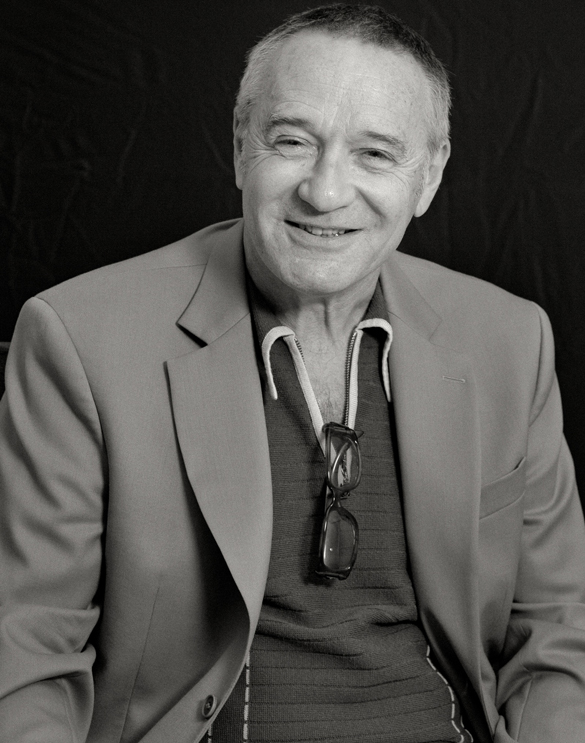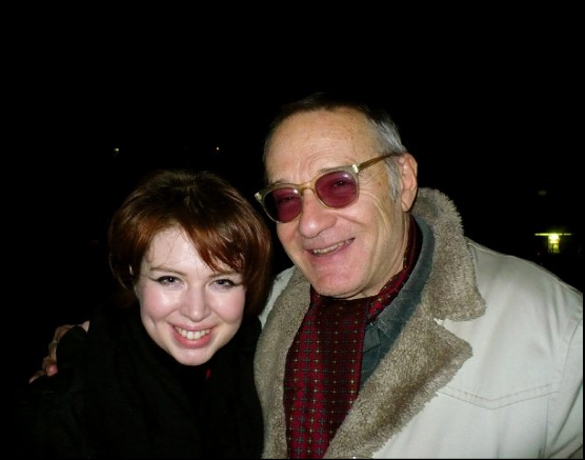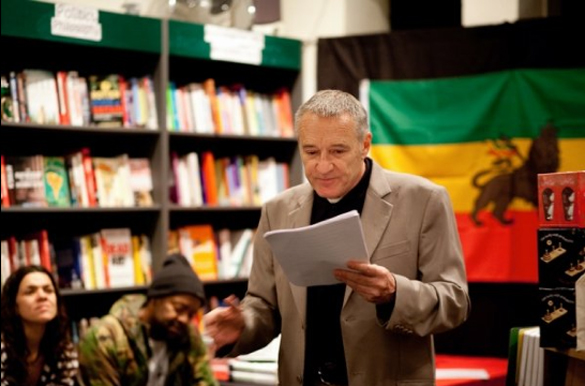Blokes Of Britain: Chris Salewicz
NAME: Chris Salewicz
RESIDES: London
OCCUPATION: Writer
Chris Salewicz is a neighbour and friend. My admiration for his work harks back more than three decades, when his words shone from the pages of the NME.
As detailed by In Their Own Write, this was no mean feat since Salewicz was part of the formidable team whose members included (deep breath): Max Bell, Angie Errigo, Pete Erskine, Mick Farren, Chrissie Hynde, Nick Kent, Nick Logan, Ian MacDonald, Kate Phillips, Charles Shaar Murray, Neil Spencer, Tony Tyler…
Now Salewicz deals in big subjects as an author, broadcaster and film-maker: his Strummer and Marley books capture the definitive portraits of these imposing figures, while involvement in such ventures as the documentary Beats Of Freedom denotes a mature reflection on his Polish roots.
In addition, Salewicz’s role as an aide-de-camp in Mick Jones’ ongoing Rock & Roll Public Library project betrays the highly attuned visual sensibilities conveyed in these, his answers to the Blokes Of Britain Questionnaire:
How would you describe your style?
It all comes from the look of mod but I got into clothes – like the rest of my generation – a bit earlier, when I was 10 and came across Elvis for the first time. At Woolworth’s in Harrogate I bought two Slim Jim ties for five shillings each. That was my first sartorial move but I never got to wear them; my mother made me take them back.
Around the time I saw The Beatles on the same bill as Acker Bilk in Leeds in the early 60s I’d have been wearing a needle-cord three-button jacket, suede shoes, that stuff. Leeds was very important because it was a clothes manufacturing base and had a very sharp mod scene based around Tonik suits and cavalry twill trousers. Like a lot of guys I’d buy the cloth and have clothes made: parallel trousers with 16″ bottoms, a blue chalk-stripe suit, a plain grey one. The Leeds branch of Cecil Gee sold fantastic tab collared shirts.
How has your look changed over the years?
It moved with the times. By 1967 the trousers I was having made would have higher waists with broader flares and jackets with a half-belt at the back. A year earlier I was coming to London and buying great shoes from Ravell’s, black slip-ons or ones with side-buckles. You really had to seek this stuff out.
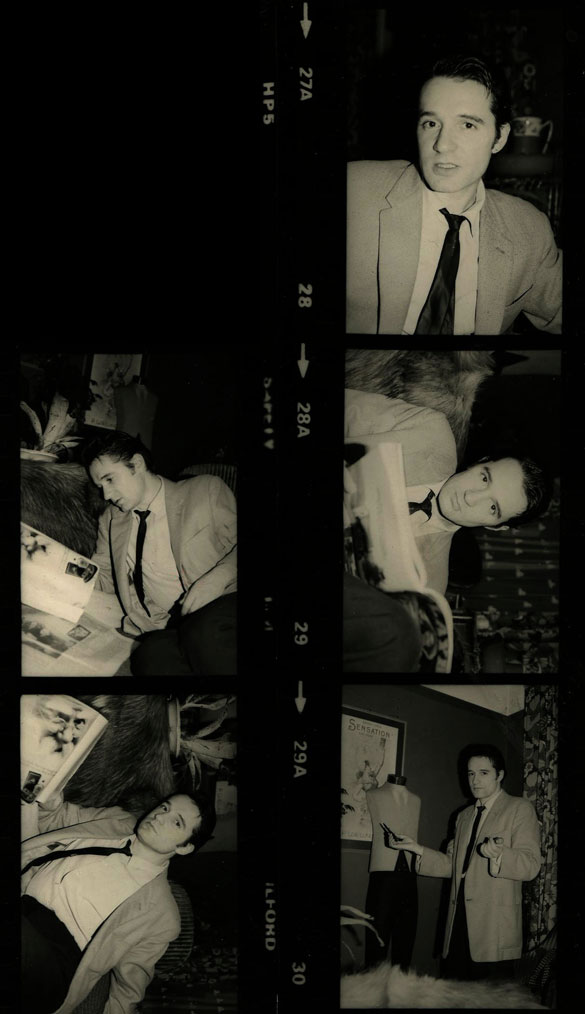
//Contact sheet of photos taken by Salewicz's then-girlfriend Versa Manos at their flat in Putney, south London, late 1980. Jacket Australian thrift-store, black/blue fleck trousers Johnsons.//
I also hitched up to Marcus Price in Newcastle which was very famous in the north, so it was no surprise to find later that Ferry really rated it. I went a few times, once to the Club-A-Go-Go and on another occasion with my friend Jim Carter, who’s now a pretty big actor. I bought plaid bell-bottoms there, I remember. In this period I had a brown suede coat, which I worked on the Christmas post to raise the money to buy.
When I moved to London I found Cockell & Johnson in Kensington Market and bought repeat-print shirts and great suits there, including a green needle-cord three-piece two-button fin-lapel number. That place was like Nirvana, though you could also find pieces in such unlikely places as Take Six.
I got a fantastic suit there – Johnny Rotten wore a Take Six tweed jacket when he visited Jamaica in 1978. I bought shirts from Deborah & Clare, which was in Beauchamp Place where I got my hair cut at Sweeney’s. Squire, Village Gate and Stirling Cooper were the places for trousers, and Andy’s Of Shepherd’s Bush made boots for around £16 a pair.
Johnson’s was great, particularly for the kind of jackets I like and still wear, and also Jones, which was a hub of many different labels and ideas. Woodhouse was popular on the soul and jazz-funk scenes and stocked Stone Island when it was completely unknown. All of this gear was sported at Fresh on Thursdays at Legends, where you’d also see guys in Crolla.
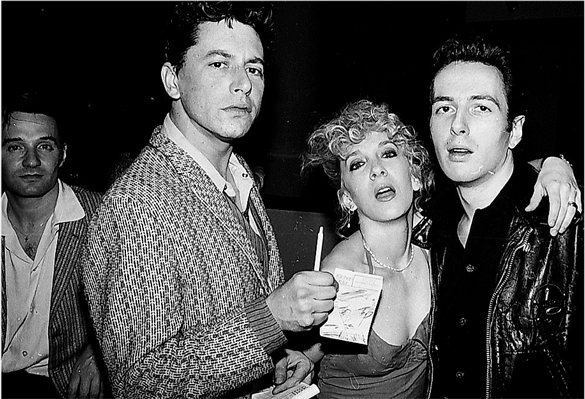
//From left: Salewicz (shirt Trash + Vaudeville, jacket Australian thrift-store); Joe Ely, unknown, Joe Strummer. Party given by Mick Jones for Ellen Foley's birthday, Interferon, New York, June 1981. Photo: Joe Stevens.//
When did you adopt your trademark Gabicci shirt/sports jacket style?
I guess it was the 70s. It really goes back to those mod days but was updated with a mixture of Rat Pack and Rude Boy. I was following reggae as it developed and Jamaican guys would be wearing fantastic shirts. You’d see photos of I-Roy in very cool gear.
I was living in south London so went to places like The Baron. I saw Lucky Gordon not that long ago and he was carrying a Baron bag, very cool. One point to be made is that these clothes could be expensive. Gabiccis cost a lot; £80 a pop in the early 80s, a lot of money.
Also I went to Australia around that time and found amazing stuff in their thrift stores. Late 50s shirts, early 60s jackets in grey with silver flecks, I bought so much I had it shipped back. I guess those clothes helped set my look.
Do you keep clothes/have you a big wardrobe?
Yes. I’ve kept a lot. I like having them hanging out, as art objects. At the moment I’ve got a Paul Smith summer suit – gray with a pink stripe – on the wall upstairs. It’s great to look at.
I also replicate originals. The chinos I’m wearing as we speak were cut from a pair of bought at Jones in the King’s Road around 86. I’ve had several made since then, first in Jamaica and these days at a place in Berwick Street or by a bloke I go to in Brick Lane. Even though I’ve got a lot of clothes, I still like to buy single pieces from a variety of places, picking up something at a Paul Smith outlet sale or somesuch.
Paul Smith is someone I respect. He has really great shoes in particular. I found a pair of suede brogues I got from him in 1987 or so and they’re still good to go. John Moore is another who was great for shoes.
What garment would you like to wear/have most in the whole wide world?
Got to be those Slim Jims my mother made me take back to Woolies in Harrogate all those years ago! One was ice-blue, the other silvery grey.
Is there a period in fashion with which you align yourself?
I guess it would be the late 50s/early 60s look which came together in mod.
The early 70s were also very interesting for fashion and menswear in particular, and are wrongly derided in my view. There was a lot of choice. It was a melting pot of ideas, some of which were quite radical.
What’s your style tip of the moment?
Ties. I’ve got some beautiful Art Deco design ties from Woodhouse which I’ve had cleaned and wear to parties. I’ve noticed other guys are doing it as well. A tie looks great, maketh the man.
Who sums up the word “stylish” for you?
De Niro in Casino. Those suits, man! The colours are fucking fantastic! There’s a pink jacket he wears in one scene which is incredible. If I could have anything in the world I want his wardrobe from that movie.

